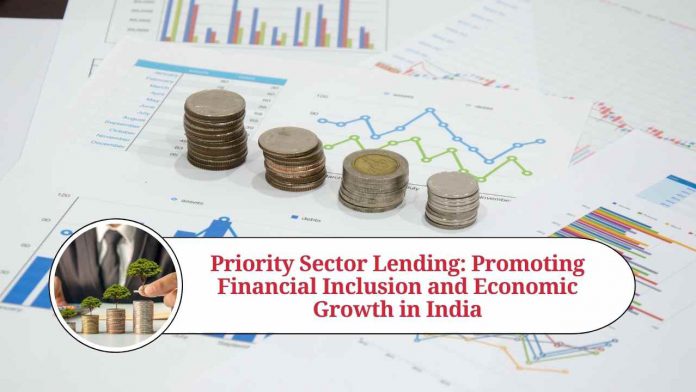Understanding Priority Sector Lending in India
Priority sector lending refers to the credit allocation made by banks and financial institutions towards certain sectors of the economy that require special attention and support. In India, priority sector lending has been a crucial component of the country’s economic policies since 1969, when the government introduced it as a means of directing credit towards sectors that were neglected by banks.
Priority sector lending is an important tool for promoting financial inclusion and economic growth. The Reserve Bank of India (RBI) has set targets for banks and financial institutions to meet in terms of priority sector lending. In this blog, we will discuss the various aspects of priority sector lending in India.
What are the sectors covered under Priority Sector Lending?
Priority sector lending covers a wide range of sectors, including agriculture, micro and small enterprises, education, housing, export credit, renewable energy, and social infrastructure. The RBI has set specific targets for each of these sectors, which banks and financial institutions are required to meet.
Agriculture is the largest sector covered under priority sector lending, with a target of 18% of the adjusted net bank credit (ANBC) or credit equivalent amount of off-balance sheet exposure, whichever is higher. Micro and small enterprises have a target of 7.5% of ANBC or credit equivalent amount of off-balance sheet exposure, while housing loans have a target of 40% of the total priority sector lending.
Why is Priority Sector Lending important?
Priority sector lending is important for several reasons. First, it promotes financial inclusion by directing credit towards sectors that are often neglected by banks. This ensures that individuals and businesses in these sectors have access to credit at reasonable rates and can contribute to the country’s economic growth.
Second, priority sector lending helps in the development of certain sectors of the economy, such as agriculture and micro and small enterprises, which are crucial for the country’s overall development.
Third, priority sector lending helps in achieving certain social objectives, such as promoting education, healthcare, and housing for all.
How are targets for Priority Sector Lending set?
The RBI sets targets for priority sector lending for banks and financial institutions. The targets are revised periodically and are based on factors such as the size of the bank, its geographical reach, and the proportion of its lending to priority sectors.
Banks and financial institutions are required to report their progress towards meeting the priority sector lending targets to the RBI. Failure to meet the targets can result in penalties.
Importance of Priority Sector Lending for Economic Growth
Priority sector lending is considered an important aspect of India’s financial sector development. It helps to provide financial support to sectors that are critical for the country’s economic growth, such as agriculture, small and medium-sized enterprises (SMEs), and affordable housing.
Agriculture, in particular, has been the backbone of India’s economy for centuries, providing employment to more than half of the country’s population. However, due to the lack of credit facilities, many farmers and rural households have been unable to access adequate financial resources to support their businesses. Priority sector lending helps to bridge this gap by providing affordable credit facilities to farmers and other rural households, enabling them to invest in their businesses and increase their productivity.
Similarly, SMEs play a critical role in India’s economy by providing employment opportunities, contributing to GDP growth, and promoting innovation. However, many of these businesses are unable to access credit facilities due to their size, lack of collateral, or other factors. Priority sector lending provides SMEs with affordable credit facilities, enabling them to expand their businesses and create more employment opportunities.
Another important sector covered under priority sector lending is affordable housing. In a country where more than 50% of the population resides in inadequate housing, priority sector lending provides access to credit facilities for individuals and families who are otherwise unable to afford housing.
Targets and Challenges
The Reserve Bank of India (RBI) sets targets for banks and financial institutions for priority sector lending. These targets are revised periodically and are based on factors such as the size of the bank, its geographical reach, and the proportion of its lending to priority sectors. Banks and financial institutions are required to report their progress towards meeting the priority sector lending targets to the RBI. Failure to meet the targets can result in penalties.
However, meeting the priority sector lending targets can be a challenge for banks and financial institutions. Often, these institutions are hesitant to lend to priority sectors due to perceived risks or lack of adequate collateral. In addition, there is a lack of infrastructure and support systems in many priority sectors, which can make lending to these sectors more challenging.
Conclusion
Priority sector lending is an important aspect of India’s financial sector development. It promotes financial inclusion, supports critical sectors of the economy, and helps to achieve social objectives such as affordable housing and education. While there are challenges in meeting the priority sector lending targets, with the right policies and implementation, priority sector lending can play a significant role in the country’s economic development.
Read more useful content:
Frequently Asked Questions (FAQs)
What is priority sector lending?
Priority sector lending refers to the credit allocation made by banks and financial institutions towards certain sectors of the economy that require special attention and support. These sectors may include agriculture, micro and small enterprises, education, housing, export credit, renewable energy, and social infrastructure.
Why is priority sector lending important?
Priority sector lending is important for promoting financial inclusion and economic growth. It directs credit towards sectors that are often neglected by banks, ensuring that individuals and businesses in these sectors have access to credit at reasonable rates and can contribute to the country’s economic growth. It also helps in achieving social objectives such as promoting education, healthcare, and housing for all.
What are the sectors covered under priority sector lending?
Priority sector lending covers a wide range of sectors, including agriculture, micro and small enterprises, education, housing, export credit, renewable energy, and social infrastructure.
What are the targets set for priority sector lending in India?
The Reserve Bank of India (RBI) has set specific targets for each sector covered under priority sector lending. Agriculture has a target of 18% of the adjusted net bank credit (ANBC) or credit equivalent amount of off-balance sheet exposure, while micro and small enterprises have a target of 7.5% of ANBC or credit equivalent amount of off-balance sheet exposure. Housing loans have a target of 40% of the total priority sector lending.
How are priority sector lending targets set?
The RBI sets targets for priority sector lending for banks and financial institutions based on factors such as the size of the bank, its geographical reach, and the proportion of its lending to priority sectors.
What are the penalties for failing to meet the priority sector lending targets?
Failure to meet the priority sector lending targets can result in penalties, which may include a reduction in the interest rate on deposits, a higher cash reserve ratio, or a lower priority sector lending certificate fee.
How can individuals and businesses access priority sector lending?
Individuals and businesses can access priority sector lending by approaching banks and financial institutions that offer credit facilities for the specific sector they are engaged in.
Can foreign banks operating in India participate in priority sector lending?
Yes, foreign banks operating in India are also required to participate in priority sector lending.
What is the role of the National Bank for Agriculture and Rural Development (NABARD) in priority sector lending?
NABARD is responsible for providing refinancing facilities to banks and financial institutions for priority sector lending in agriculture and rural development.
How has priority sector lending contributed to India’s economic growth?
Priority sector lending has contributed significantly to India’s economic growth by promoting financial inclusion, supporting critical sectors of the economy, and achieving social objectives such as affordable housing and education. It has enabled individuals and businesses in neglected sectors to access credit at reasonable rates, expanding their businesses and contributing to the country’s economic growth.




















